Past visitors and alumni of our lab
Andrea Pozzi, research intern
 I have a long standing passion for science, in fact since high school I have been practicing in chemistry and biology labs. I then obtained my Bsc in Biotechnology and Msc in Biodiversity and Evolution, during which I discovered a new kind of small non coding RNA that I named smithRNA. I am well aware, however, that science is not all about experiments; in fact talking with other scientists is one of the keys to progress. That is why I love traveling to meet new researchers and to discover new things. Now I am at the Okinawa Institute of Science and Technology to study the regulation of venom expression in snakes. Here, under the guidance of Prof. Mikheyev, I am trying to unearth how closely related snakes have such different phenotypes in venom expression. My interests span from molecular zoology to anthropology to forensics sciences to computer science, paleontology, and much more.
I have a long standing passion for science, in fact since high school I have been practicing in chemistry and biology labs. I then obtained my Bsc in Biotechnology and Msc in Biodiversity and Evolution, during which I discovered a new kind of small non coding RNA that I named smithRNA. I am well aware, however, that science is not all about experiments; in fact talking with other scientists is one of the keys to progress. That is why I love traveling to meet new researchers and to discover new things. Now I am at the Okinawa Institute of Science and Technology to study the regulation of venom expression in snakes. Here, under the guidance of Prof. Mikheyev, I am trying to unearth how closely related snakes have such different phenotypes in venom expression. My interests span from molecular zoology to anthropology to forensics sciences to computer science, paleontology, and much more.
In my spare time I like watching movies, playing games and exploring new places.
Christine Guzman, Rotation student
 I am interested in studying the molecular mechanisms underlying the adaptation and resilience of marine organisms to changing ocean conditions. I am also fascinated by early animal evolution and the concept of ‘human-assisted’ evolution in corals.
In my previous work, I have built and characterized the transcriptomes of several sponge and coral species. Now, the goal of my rotation project in the Ecology and Evolution Unit at OIST, is to understand the molecular basis of host use associated behaviors in the checkerspot butterfly species, Euphydryas editha populations. I love how Okinawa, with its weather and beautiful beaches, looks pretty much the same with my home country, the Philippines.
I am interested in studying the molecular mechanisms underlying the adaptation and resilience of marine organisms to changing ocean conditions. I am also fascinated by early animal evolution and the concept of ‘human-assisted’ evolution in corals.
In my previous work, I have built and characterized the transcriptomes of several sponge and coral species. Now, the goal of my rotation project in the Ecology and Evolution Unit at OIST, is to understand the molecular basis of host use associated behaviors in the checkerspot butterfly species, Euphydryas editha populations. I love how Okinawa, with its weather and beautiful beaches, looks pretty much the same with my home country, the Philippines.
Miquel Grau-Lopez, research technician
 I obtained my degree in Computer Systems Engineering from the Universitat Jaume I at Castello (Spain) where I developed, for my final degree project, a web application for the main hospital. After that, I worked for several years designing tools to facilitate researchers’ work related with photovoltaic and optoelectronic devices for Physics Department at the University. I arrived to Ecology and Evolution Unit on 2013 where I am working with several projects, testing apps and building pipeline tools. My interest in this field grows up as I read and learn more. We have focused in the genome study of several species like ants, birds or snakes and it is very exciting.
I obtained my degree in Computer Systems Engineering from the Universitat Jaume I at Castello (Spain) where I developed, for my final degree project, a web application for the main hospital. After that, I worked for several years designing tools to facilitate researchers’ work related with photovoltaic and optoelectronic devices for Physics Department at the University. I arrived to Ecology and Evolution Unit on 2013 where I am working with several projects, testing apps and building pipeline tools. My interest in this field grows up as I read and learn more. We have focused in the genome study of several species like ants, birds or snakes and it is very exciting.
On a personal level, I love travelling and discovering new cultures. I really like reading/writing and spend time with friends, music, games and cinema. Of course, I like soba!
Jo Tan, research technician
 Konnichiwa! I’m a lab technician in the Mikheyev Unit which is under the Ecology and Evolution umbrella at OIST. At this stage, I am fortunate enough to be involved in a unique project collaborating with Evan Economo and his colleagues in which we will be extracting, sequencing and correlating DNA from Fijian Ants museum samples. I’ve have previously graduated from the University of Auckland, and more recently been involved with Stemcell Technologies in Sydney Australia. As you can probably tell, we are a progressive and dynamic lab, from all around the world, with different cultures and background. We work hard and play hard, and have fun as a team and I’m grateful to be a part of this awesome group.
Konnichiwa! I’m a lab technician in the Mikheyev Unit which is under the Ecology and Evolution umbrella at OIST. At this stage, I am fortunate enough to be involved in a unique project collaborating with Evan Economo and his colleagues in which we will be extracting, sequencing and correlating DNA from Fijian Ants museum samples. I’ve have previously graduated from the University of Auckland, and more recently been involved with Stemcell Technologies in Sydney Australia. As you can probably tell, we are a progressive and dynamic lab, from all around the world, with different cultures and background. We work hard and play hard, and have fun as a team and I’m grateful to be a part of this awesome group.
Lauren Dembek, postdoc, 2014-2015
 I am fascinated by the immense diversity and peculiarity of life on Earth. In order to understand how complex traits evolve, potentially resulting in richer biodiversity, we must identify the genetic variants that underlie variation in those traits. I am currently studying behavioral and genetic variation in the honey bee. In addition to my research, I am a writer for the Association for Women in Science and a member of the Genetics Society of America’s Mentoring and Professional Development Committee.
I am fascinated by the immense diversity and peculiarity of life on Earth. In order to understand how complex traits evolve, potentially resulting in richer biodiversity, we must identify the genetic variants that underlie variation in those traits. I am currently studying behavioral and genetic variation in the honey bee. In addition to my research, I am a writer for the Association for Women in Science and a member of the Genetics Society of America’s Mentoring and Professional Development Committee.
During my Ph.D., I researched the genetic architecture of natural variation in body pigmentation and cuticular hydrocarbon composition in the Drosophila melanogaster Genetic Reference Panel with Prof. Trudy Mackay at North Carolina State University and W. M. Keck Center for Behavioral Biology. I also studied mimicry, mate choice, and the speciation continuum in Heliconius butterflies with Dr. W. Owen McMillan at the Smithsonian Tropical Research Institute in Panama. I graduated with a B.S. in Biology and B.A. in Foreign Languages from West Virginia University. While there, I worked with Dr. David A. Ray using accumulated genetic variation in retrotransposons to reconstruct the phylogenetic relationships of crocodiles, alligators, and gharials. I was fortunate to continue this research as a McNair Scholar through the Ronald E. McNair Post-Baccalaureate Achievement Program at WVU.
Natively, I come from Wallace, WV. During my youth, I trained to be a skilled outdoorswoman, fishing, catching crawdads and salamanders, climbing trees, shooting inanimate objects, driving vehicles through large mud holes, and rescuing kittens. These days, I enjoy exploring nature and meeting new organisms, yoga, knitting, photography, and cuddling with my feline companions Dennis and Merriam.
Mandy Tin, research technician 2012-2015
 I mainly work on projects involve research and development of innovative ways to retrieve valuable genomic information from archival museum specimens while preserving their morphology for taxonomic purpose. Our very first version of library preparation method has been published recently. The method is under active development, and we are extending the technology to ancient human DNA research. Lab automation is a big part of my interest as well. We have successfully automated some of the routine library preparation procedures. Robots allow us to increase throughput with high reproducibility. I also deal with general molecular work in the lab. As I have seen a lot of degraded DNA, now I am always amazed when I see good quality RNA and DNA.
I mainly work on projects involve research and development of innovative ways to retrieve valuable genomic information from archival museum specimens while preserving their morphology for taxonomic purpose. Our very first version of library preparation method has been published recently. The method is under active development, and we are extending the technology to ancient human DNA research. Lab automation is a big part of my interest as well. We have successfully automated some of the routine library preparation procedures. Robots allow us to increase throughput with high reproducibility. I also deal with general molecular work in the lab. As I have seen a lot of degraded DNA, now I am always amazed when I see good quality RNA and DNA.
I started working on non-model organisms in this lab and have learnt a lot of fascinating stories about them. For example, Wasmannia auropunctata, the little fire ant, has clonal reproductive system for queens and males but sexual reproduction for workers. Some ant species have evolved strategies to exploit resources of other ant species without being discovered (social parasitism). I hope you find evolution interesting too!
Carolina Diaz, postdoc, 2014-2015
 I am a researcher in molecular evolution, my research interests has revolved around the role of mutations as a source of phenotypic diversity or genetic deterioration.
I worked on the molecular origins of life using bottleneck population sizes of ribozymes evolved continuously to test the effect of the accumulation of mutations in the survival of the populations, and the potential routes that they can explore to escape extinction. I also worked on a project to measure the effect of mutations recently acquired depending on their interactions with other genes, epistasis, using natural isolates of E. coli.
During my career I have had several teaching and mentoring opportunities, including teaching science classes for fourth, fifth and sixth graders in Colombia, planning and doing science projects, teaching general chemistry laboratory for first and second year college students. I have also volunteered mentoring science projects at a charter school in Houston.
In addition to my career in science, I have painted in fabric with acrylics, gouache, oils, and on paper with water colors, black color, pastels, and ink.
I am a researcher in molecular evolution, my research interests has revolved around the role of mutations as a source of phenotypic diversity or genetic deterioration.
I worked on the molecular origins of life using bottleneck population sizes of ribozymes evolved continuously to test the effect of the accumulation of mutations in the survival of the populations, and the potential routes that they can explore to escape extinction. I also worked on a project to measure the effect of mutations recently acquired depending on their interactions with other genes, epistasis, using natural isolates of E. coli.
During my career I have had several teaching and mentoring opportunities, including teaching science classes for fourth, fifth and sixth graders in Colombia, planning and doing science projects, teaching general chemistry laboratory for first and second year college students. I have also volunteered mentoring science projects at a charter school in Houston.
In addition to my career in science, I have painted in fabric with acrylics, gouache, oils, and on paper with water colors, black color, pastels, and ink.
Misato Okamoto Miyakawa, postdoc 2012-2014
 I am interested in the evolution of conflict in organisms. Conflicts can be detected at various levels, e.g. between selfish genes and resistant genes, parasite and host species, males and females. In social insects, conflicts among colony members often arise over optimal reproductive strategies. Given this, I am particularly interested in the genetics and behavioral ecology involved in conflicts that positively affect the evolution of sociality in insects. In my postdoc, I have focused on ants that have an unique reproductive strategy, Wasmannia auropunctata and Vollenhovia emeryi, which seem to have conflict between sexes. Using sequencing technology and bioinfomatic tools, I seek to understand the evolutionary advantage of this reproductive strategy.
I’m really happy to work at OIST for my first postdoc, particularly because of my great lab members, the beautiful working environment, and the almost infinite budget for research. The Ecology and Evolution unit is a great place to improve molecular experimental techniques and increase your mental powers!
I am interested in the evolution of conflict in organisms. Conflicts can be detected at various levels, e.g. between selfish genes and resistant genes, parasite and host species, males and females. In social insects, conflicts among colony members often arise over optimal reproductive strategies. Given this, I am particularly interested in the genetics and behavioral ecology involved in conflicts that positively affect the evolution of sociality in insects. In my postdoc, I have focused on ants that have an unique reproductive strategy, Wasmannia auropunctata and Vollenhovia emeryi, which seem to have conflict between sexes. Using sequencing technology and bioinfomatic tools, I seek to understand the evolutionary advantage of this reproductive strategy.
I’m really happy to work at OIST for my first postdoc, particularly because of my great lab members, the beautiful working environment, and the almost infinite budget for research. The Ecology and Evolution unit is a great place to improve molecular experimental techniques and increase your mental powers!
Valentin Churavy, masters student
 I am a PhD student at OIST in the Ecology and Evolution Lab. I came to Okinawa because of the interdisciplinary atmosphere and the fantastic research environment.
I am a PhD student at OIST in the Ecology and Evolution Lab. I came to Okinawa because of the interdisciplinary atmosphere and the fantastic research environment.
I did my undergraduate studies in Cognitive Science at the University of Osnabrück (Germany) on social robotics and neurodynamics. My primary focus was on biologically inspired artificial systems – evolutionary robotics, artificial life and artificial neural networks. For my PhD I am shifting from artificial systems to living systems. I plan to model large scale social behaviour in social insects, particularly interest to me are the social dynamics in honeybee colonies. Here at OIST I am in the lucky position of applying my knowledge and passion for programming and machine learning to develop new approaches to research topics in biology.
I enjoy long-distance hiking, bouldering and discovering/cooking new food. I am also involved in open-source software development and in my free time I read books and play the basson.
Marie Uemura, intern, 2016
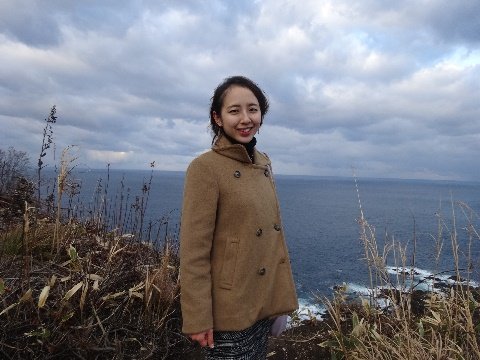 I have interests in ecosystem and ecological interaction. Especially I’m interested in relationship with forest and river ecology. At OIST in this Ecology and Evolution unit, I have researched about phylogenetic tree of insects using genomic data. During my research, I also study about computing method and how to use genetic information. Because I wanted to study about another field from mine, it was a great opportunity to studying about new thing and acquire skills or knowledge.
I’m junior in Hokkaido University now, and going to start my senior year in this spring. I want to make use of this experience at OIST in my research. Actually, I’m going to research about microorganisms that relates to denitrification and quality of water in rivers. And how they are affected by adjacent forest form, e.g. artificial forest, conifer forest.
I have interests in ecosystem and ecological interaction. Especially I’m interested in relationship with forest and river ecology. At OIST in this Ecology and Evolution unit, I have researched about phylogenetic tree of insects using genomic data. During my research, I also study about computing method and how to use genetic information. Because I wanted to study about another field from mine, it was a great opportunity to studying about new thing and acquire skills or knowledge.
I’m junior in Hokkaido University now, and going to start my senior year in this spring. I want to make use of this experience at OIST in my research. Actually, I’m going to research about microorganisms that relates to denitrification and quality of water in rivers. And how they are affected by adjacent forest form, e.g. artificial forest, conifer forest.
I enjoy the relax lifestyle in Okinawa and beautiful scenery of blue ocean. In my free time, I love watching musical show, playing with dogs and traveling.
Rob Campbell, rotation student, fall 2015
 I completed my undergraduate studies at Skidmore College (United States), earning a dual degree in physics and international affairs. I then spent several years working in communications and international sustainable development before returning to the research world and arriving here at OIST for my PhD. I came to OIST for the chance to integrate my interest in micro and nano-scale physics with my childhood passion for ecology, which was what propelled me into science in the first place, and I’m thrilled to spend my first rotation in the EcoEvo Lab. My project is focused on the parasitoid phorid fly genus Pseudacteon, using x-ray microtomography (micro-CT) to visualize different stages of Pseudacteon obtusus’ development inside their fire ant hosts. In my free time I’m all about food, foreign language, and the ocean, and I love taking advantage of all three here in Okinawa!
I completed my undergraduate studies at Skidmore College (United States), earning a dual degree in physics and international affairs. I then spent several years working in communications and international sustainable development before returning to the research world and arriving here at OIST for my PhD. I came to OIST for the chance to integrate my interest in micro and nano-scale physics with my childhood passion for ecology, which was what propelled me into science in the first place, and I’m thrilled to spend my first rotation in the EcoEvo Lab. My project is focused on the parasitoid phorid fly genus Pseudacteon, using x-ray microtomography (micro-CT) to visualize different stages of Pseudacteon obtusus’ development inside their fire ant hosts. In my free time I’m all about food, foreign language, and the ocean, and I love taking advantage of all three here in Okinawa!
Jigyasa Arora, intern spring 2015
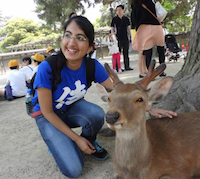 I am from New Delhi, India. I am a research intern in The Ecology and Evolution Unit at OIST. I am working on snake venomics to understand venom evolution and adaptation in response to prey population. I am really enjoying learning molecular biology techniques required for this project. I have a masters in Molecular Medicine from University of Essex, U.K. In my spare time, I love dancing and basketball.
I am from New Delhi, India. I am a research intern in The Ecology and Evolution Unit at OIST. I am working on snake venomics to understand venom evolution and adaptation in response to prey population. I am really enjoying learning molecular biology techniques required for this project. I have a masters in Molecular Medicine from University of Essex, U.K. In my spare time, I love dancing and basketball.
Dorothy J. Immaculate, intern, spring 2015
 The Biological questions that I am interested in lie broadly in Evolution. Tracing the signatures of an organism’s adaptation to changing environmental conditions is an exciting research to undertake. I am currently enrolled in Bachelor of Technology, Genetic Engineering at SRM University, India. I am taking the Research Internship opportunity here at OIST to complete my undergraduate thesis. I love my stay here at the Mikheyev Unit. The work environment is great with plenty of resources and encouraging lab mates. My work involves the study of transgenerational epigenetic inheritance of metabolism in the model organism Drosophila melanogaster. This study aims to understand how prenatal nutritional environment affects the metabolism of an organism and if it can be epigenetically inherited and sustained through generations. Significant benefits can be obtained from this study if translated to the human model. Apart from my interest in Biology, I am an avid reader and enjoy travelling.
The Biological questions that I am interested in lie broadly in Evolution. Tracing the signatures of an organism’s adaptation to changing environmental conditions is an exciting research to undertake. I am currently enrolled in Bachelor of Technology, Genetic Engineering at SRM University, India. I am taking the Research Internship opportunity here at OIST to complete my undergraduate thesis. I love my stay here at the Mikheyev Unit. The work environment is great with plenty of resources and encouraging lab mates. My work involves the study of transgenerational epigenetic inheritance of metabolism in the model organism Drosophila melanogaster. This study aims to understand how prenatal nutritional environment affects the metabolism of an organism and if it can be epigenetically inherited and sustained through generations. Significant benefits can be obtained from this study if translated to the human model. Apart from my interest in Biology, I am an avid reader and enjoy travelling.
Maggi Mars Brisbin, rotation student, fall 2014
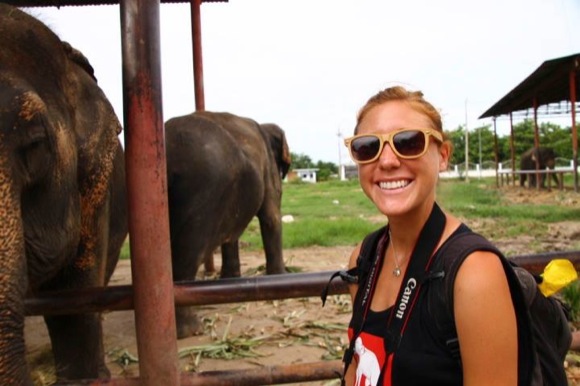 I am a first year PhD student at OIST and am completing my first laboratory rotation in the Ecology and Evolution Unit. My rotation project involves investigating transgenerational effects of diet using Drosophila as a model organism. I am looking at whether gut microbiota might play a role either by being directly inherited or by causing an epigenetic modification that is inherited. I completed my M.S. in marine and atmospheric science at Stony Brook University in New York and studied immunology and disease in the American Lobster for my thesis research. In my spare time, I enjoy distance running, yoga, and crossfit. I try to spend free time in or near the ocean, and I have been enjoying the beautiful diving in Okinawa.
I am a first year PhD student at OIST and am completing my first laboratory rotation in the Ecology and Evolution Unit. My rotation project involves investigating transgenerational effects of diet using Drosophila as a model organism. I am looking at whether gut microbiota might play a role either by being directly inherited or by causing an epigenetic modification that is inherited. I completed my M.S. in marine and atmospheric science at Stony Brook University in New York and studied immunology and disease in the American Lobster for my thesis research. In my spare time, I enjoy distance running, yoga, and crossfit. I try to spend free time in or near the ocean, and I have been enjoying the beautiful diving in Okinawa.
Jatin Arora, research intern, 2014
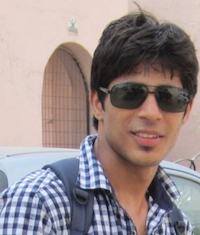 It fascinates me that four nucleotides with different permutations and combinations, which I also think as the algorithm of the nature, code for all diverse forms of life. On the other side, advancements in computer science are enabling us to carry out unprecedented tasks. Being motivated by this synergetic relationship, I studied Bioinformatics and Modelling at University Pierre and Marie Curie in Paris. I have profound interest in evolution. I believe that understanding the evolution is the key to understand the functional complexities of organisms. I have worked on a range of evolutionary topics like retention of ohnolog genes from whole genome duplication, natural selection in honey bees etc. I am also very interested in the implications of genetic variation in molecular traits and diseases in human. Additionally, I have developed special interest in immunogenomics. Evolution has not been an easy path as organisms have to cope with a vast spectrum of pathogens besides environmental changes. I am interested in how organism evolve and develop their defence mechanisms against invading pathogens with different genetic backgrounds. Besides scientific interest, I am deeply fond of learning languages, music and dance especially punjabi, and kick-boxing.
It fascinates me that four nucleotides with different permutations and combinations, which I also think as the algorithm of the nature, code for all diverse forms of life. On the other side, advancements in computer science are enabling us to carry out unprecedented tasks. Being motivated by this synergetic relationship, I studied Bioinformatics and Modelling at University Pierre and Marie Curie in Paris. I have profound interest in evolution. I believe that understanding the evolution is the key to understand the functional complexities of organisms. I have worked on a range of evolutionary topics like retention of ohnolog genes from whole genome duplication, natural selection in honey bees etc. I am also very interested in the implications of genetic variation in molecular traits and diseases in human. Additionally, I have developed special interest in immunogenomics. Evolution has not been an easy path as organisms have to cope with a vast spectrum of pathogens besides environmental changes. I am interested in how organism evolve and develop their defence mechanisms against invading pathogens with different genetic backgrounds. Besides scientific interest, I am deeply fond of learning languages, music and dance especially punjabi, and kick-boxing.
Shikha Aggarwal, research intern, January-May 2014
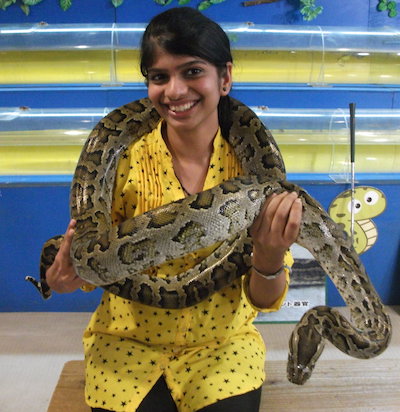 I am from Delhi, the capital city of India. Born and brought up in the second most crowded metropolis city in India, I always yearned to be close to nature. I have a background in biological sciences (bachelors) and Biodiversity and conservation (Masters). I am interested in ecology and appreciated its role in corroborating the many theories and principles in evolutionary biology. My broad area of interest is population genetics, molecular phylogeny and wildlife forensics. My internship project involved the proteomic analysis of venom characterization from a local snake (Protobothrops flavoviridis : Okinawa habu), an invasive snake (Protobothrops elegans :Sakishima habu) and their naturally produced hybrid. I learned designing of several protein cleavage protocols, cDNA sequencing combined with MS profiling. This definitely helped to enhance my knowledge and working skills. This internship project proved out to be the best dissertation thesis report of my masters in my college and helped me to score very well. During my stay in OIST, I also learned to photograph and digitize landmarks on pinned bee specimens from museum, using a sophisticated imaging setup. OIST is a great place to work at because of friendly and beautiful environment, great lab members belonging to different cultures and origin, best mentor and well equipped labs. I wish to adopt challenging profession in wildlife research, with opportunity for advancement and would like to explore my innovative skills, where I can put forth my efforts for the conservation of wildlife. In my free time, I love photography, dancing, music and painting.
I am from Delhi, the capital city of India. Born and brought up in the second most crowded metropolis city in India, I always yearned to be close to nature. I have a background in biological sciences (bachelors) and Biodiversity and conservation (Masters). I am interested in ecology and appreciated its role in corroborating the many theories and principles in evolutionary biology. My broad area of interest is population genetics, molecular phylogeny and wildlife forensics. My internship project involved the proteomic analysis of venom characterization from a local snake (Protobothrops flavoviridis : Okinawa habu), an invasive snake (Protobothrops elegans :Sakishima habu) and their naturally produced hybrid. I learned designing of several protein cleavage protocols, cDNA sequencing combined with MS profiling. This definitely helped to enhance my knowledge and working skills. This internship project proved out to be the best dissertation thesis report of my masters in my college and helped me to score very well. During my stay in OIST, I also learned to photograph and digitize landmarks on pinned bee specimens from museum, using a sophisticated imaging setup. OIST is a great place to work at because of friendly and beautiful environment, great lab members belonging to different cultures and origin, best mentor and well equipped labs. I wish to adopt challenging profession in wildlife research, with opportunity for advancement and would like to explore my innovative skills, where I can put forth my efforts for the conservation of wildlife. In my free time, I love photography, dancing, music and painting.
Leonidas Georgiou, rotation student, fall 2014
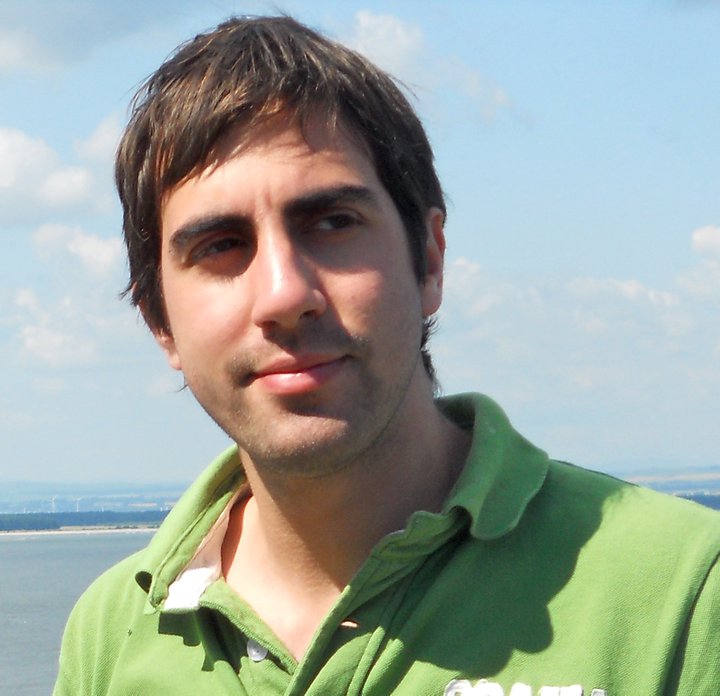 Origin: Cyprus
Background: Neuroscience
Aspiration: Combine my background with mathematics and the physical sciences to understand how life works systematically.
Interest: Biological thermodynamics. How life “captures” order. How is life related to energy and information?
Current work: Error detection and repair of ancient mitochondrial DNA using computational methods Future work: Hopefully my interest and aspiration (see above).
Origin: Cyprus
Background: Neuroscience
Aspiration: Combine my background with mathematics and the physical sciences to understand how life works systematically.
Interest: Biological thermodynamics. How life “captures” order. How is life related to energy and information?
Current work: Error detection and repair of ancient mitochondrial DNA using computational methods Future work: Hopefully my interest and aspiration (see above).
Yafei Mao, rotation student, fall 2014
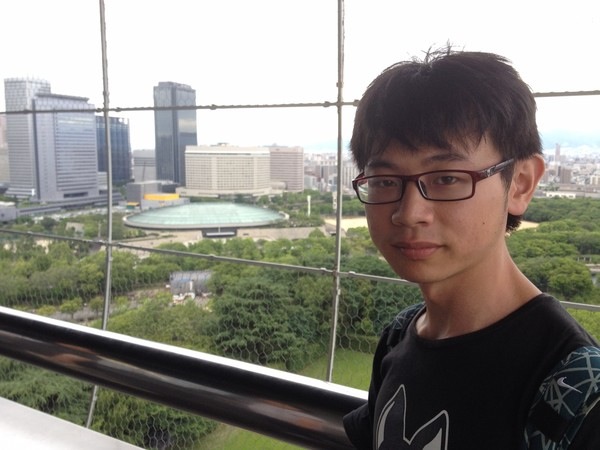 I am a first year PhD student at OIST and choose the Ecology and Evolution Unit for my first rotation. In my rotation project, I am working on estimating the effective population size for ant fauna in Cocos Island using temporal samples collected at different times. I graduated form Nanjing University in Life sciences. I have some experience on molecular biology and protein purification, but I want to come into contact with different areas of life sciences, especially for ecology and evolution. In my spare time, I enjoy swimming and traveling.
I am a first year PhD student at OIST and choose the Ecology and Evolution Unit for my first rotation. In my rotation project, I am working on estimating the effective population size for ant fauna in Cocos Island using temporal samples collected at different times. I graduated form Nanjing University in Life sciences. I have some experience on molecular biology and protein purification, but I want to come into contact with different areas of life sciences, especially for ecology and evolution. In my spare time, I enjoy swimming and traveling.
Rob Campbell, PhD student
 I am interested in the intersection of materials science and evolutionary ecology – how species take advantage of material properties for evolutionary advantage, and how biomaterial structures are influenced by their evolutionary and ecological context. In short – spider silk! A polymer material with incredible properties and a finely controlled fabrication process essential to organism survival. My thesis looks at spider silk comparatively, bringing together tools from materials science, physics, chemistry, taxonomy, and bioinformatics to contextualize variation in silk production across spider species.
I am interested in the intersection of materials science and evolutionary ecology – how species take advantage of material properties for evolutionary advantage, and how biomaterial structures are influenced by their evolutionary and ecological context. In short – spider silk! A polymer material with incredible properties and a finely controlled fabrication process essential to organism survival. My thesis looks at spider silk comparatively, bringing together tools from materials science, physics, chemistry, taxonomy, and bioinformatics to contextualize variation in silk production across spider species.
My first project in the lab was as a rotation student, using x-ray microtomography (micro-CT) to visualize parasitoid fly larvae inside their fire ant hosts. Before OIST I did my bachelor’s in physics and international affairs at Skidmore College (United States) and worked in sustainable development, international policy, and communications (United States; China). Then and now, my free time is all about food, foreign languages, and cultural exchange!
Carmen Emborski, special research
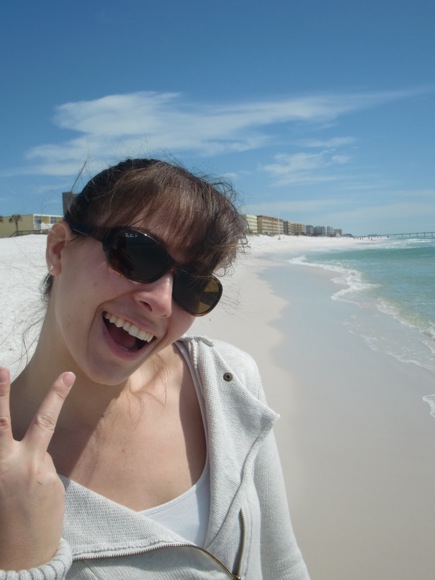 I have had a really unique opportunity to complete my studies at Texas Tech University in the U.S.A. and pursue my dissertation research here at OIST. My educational background is in biology with a focus in environmental toxicology and human health. For my research, I am studying if and how exposure to extreme diets (i.e. starvation and diets very high in sugar) within a single-generation can lead to the inheritance of metabolic syndrome (i.e. diabetes and obesity) across several generations using Drosophila melanogaster as my model organism. I am also interested in the interplay between metabolism and fitness, and more specifically how extreme diets can transgenerationally alter fitness.
I have had a really unique opportunity to complete my studies at Texas Tech University in the U.S.A. and pursue my dissertation research here at OIST. My educational background is in biology with a focus in environmental toxicology and human health. For my research, I am studying if and how exposure to extreme diets (i.e. starvation and diets very high in sugar) within a single-generation can lead to the inheritance of metabolic syndrome (i.e. diabetes and obesity) across several generations using Drosophila melanogaster as my model organism. I am also interested in the interplay between metabolism and fitness, and more specifically how extreme diets can transgenerationally alter fitness.
While here in Okinawa, and particularly while here at OIST, I have enjoyed getting to know people from many different disciplines and cultures, including the really awesome people that make up our lab. In my free time, I enjoy scuba diving, exploring the island, trying new restaurants, making new friends, and enjoying the company of friends already made. If you have any questions about OIST, this lab, or about Okinawa, feel free to email me and I’ll be happy to share my perspective and experiences.
Yoann Portugal, research technician
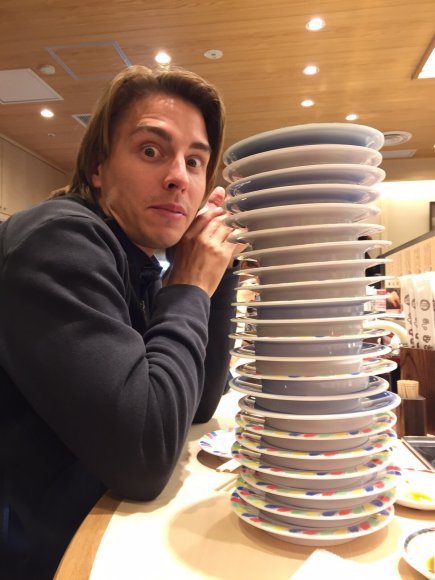 Hey! I am a technician in Mikheyev Unit here at OIST. My role in the group is to take care of the bee colonies we study and to make sure we have the optimum setup and facility to observe them. I also get involved in anything where engineering support is needed.
Before joining the lab, I was working in China for about 8 years where I was building and starting chemical production factories. I graduated from the Hogeschool Zeeland University of Applied Science, my background is in engineering and project management and I basically like getting my hands dirty and build things.
Hey! I am a technician in Mikheyev Unit here at OIST. My role in the group is to take care of the bee colonies we study and to make sure we have the optimum setup and facility to observe them. I also get involved in anything where engineering support is needed.
Before joining the lab, I was working in China for about 8 years where I was building and starting chemical production factories. I graduated from the Hogeschool Zeeland University of Applied Science, my background is in engineering and project management and I basically like getting my hands dirty and build things.
I’m glad to have this opportunity of being in Okinawa and working on super interesting subjects with a great team.
Mariana Velasque Borges, postdoc
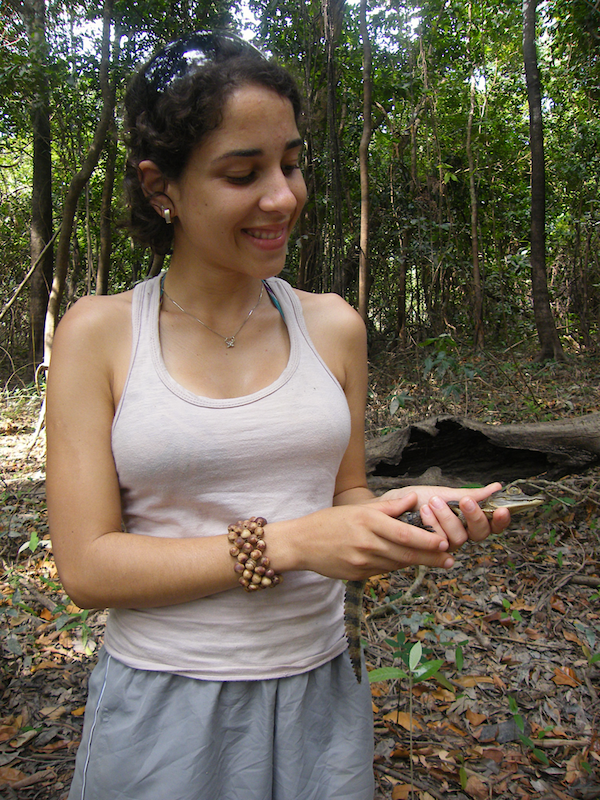 Hi there!! I am a biologist with a Masters in Ecology from Federal University of Uberlandia (Brazil). My main research interests lie in ecology and behaviour, specifically in the behavioural ecology of individual variation in behaviour. I completed my PhD at Plymouth University, UK, where I investigated the relationship between consistent individual variation in behaviour (animal personality) and its relationship with other life history traits and decision-making in hermit crabs. In OIST, I hope to expand my knowledge, incorporating genetics into the study of individual and group behaviour in honey bees.
Hi there!! I am a biologist with a Masters in Ecology from Federal University of Uberlandia (Brazil). My main research interests lie in ecology and behaviour, specifically in the behavioural ecology of individual variation in behaviour. I completed my PhD at Plymouth University, UK, where I investigated the relationship between consistent individual variation in behaviour (animal personality) and its relationship with other life history traits and decision-making in hermit crabs. In OIST, I hope to expand my knowledge, incorporating genetics into the study of individual and group behaviour in honey bees.
In my free time, I enjoy discovering new things (from cooking to playing sports), long runs and books.